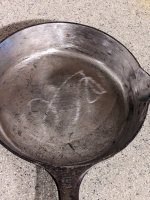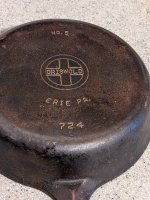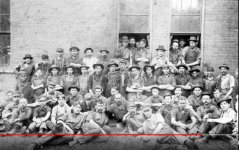He destroyed the collector value, but if you can get seasoning to stick to it, it's still a good pan.
It is never, EVER necessary to do what he did. Even a rough Lodge with smooth out adequately with use.
Like SeanD, one of my pans is pitted. Not the whole cooking surface, but one little spot on the edge has rust pitting - but the seasoning hasn't filled it in. Still, I don't even notice it when I'm cooking, nothing hangs there. That rust pitting, and the sulfur pitting on the outside bottom, just give it character. It's a Favorite Piqua Ware smiley no. 7, and if it wasn't for the rust pitting, I probably wouldn't have been able to afford it. I love that pan, warts and all. I even found a picture of the foundry workers. Conditions must have been awful - they even had kids working there. But these guys fought for some of the things we take for granted now.
As long as seasoning sticks to it, I wouldn't monkey with it any further. Once it's seasoned well, I don't think it will be noticeable. This trend of people grinding skillets unnecessarily is just one more layer of history, like rust pitting and sulphur pitting.



